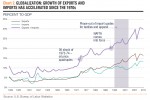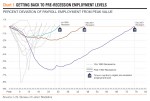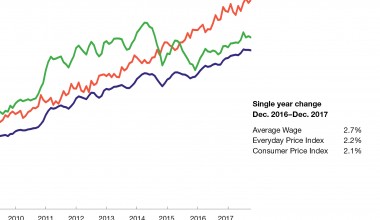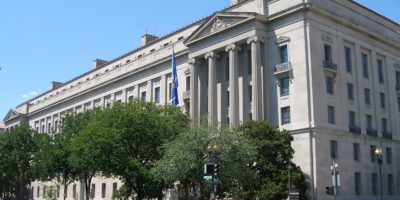The Changing Nature of Recessions
It was only in May 2014, almost five years after the recession ended, that the number of jobs returned to its 2007, pre-recession level. This slow expansion in jobs, along with a growing labor force, means that unemployment has remained stuck above 6 percent, well in excess of the 4.7 percent pre-recession rate.
The severe downturn and the persistent joblessness that followed represent the latest example of a fundamental change in the nature of recessions. Rather than arising from simple demand shocks, the Great Recession was the outcome of structural shifts in the economy that pose new challenges to companies and people. Future recessions are likely to follow the same pattern.
Long Expansions, Jobless Recoveries
The data show that the new nature of recessions first became apparent in the early 1990s, when the term “jobless recovery” was coined. While the drop in output and in employment was moderate during the recession of 1990-91, it took far longer for employment to recover. Indeed, the unemployment rate continued to rise for more than a year after the recession ended and did not fully recover until 1996.
The next downturn, in 2001, showed a similar pattern, with employment taking longer to recover than output. The long expansion of the 1990s had led some to conclude that recessions were a thing of the past, but they were wrong. (See AIER’s November 2001 Economic Bulletin, “What Will Recessions Mean to You?” https://www.aier.org/research/what-will-recession-mean-you.) Recessions remain a fact of economic life, but the data show they are less frequent, that the loss in jobs is more severe than the decline in output, and that unemployment lingers longer.
While the forces that drive recessions are complex, it is still possible to group them into two categories. There are simple shocks that interrupt economic growth, and structural shifts that force massive reallocation of capital and workers. What has changed since 1990 is that structural shifts have played a dominant role.
That recessions occur less frequently is a significant part of their changing nature. There have been 11 recessions in the 66 years since 1948 and only four recessions in the last 33 years. In addition, prior to the mid-1980s, business cycles were comparatively short. With the exception of the go-go years of the 1960s—nearly nine years of expansion that ended in December 1969—expansions lasted less than five years. As Figure 1 above shows, the modern recessions (1990, 2001, 2007) followed three of the four longest expansions on record, averaging almost eight years between downturns. As we will see, all were followed by jobless recoveries.
For a free copy of our comprehensive research study on The Changing Nature of Recessions, click here.
Structural Shifts Reflect Deep Changes
Simple recessions involve an episodic reduction in demand. In 1957, for example, businesses slowed production after a strengthening of the dollar resulted in reduced demand for U.S. exports. Once foreign demand recovered, U.S. companies restored production, and the economy returned to its pre-recession state.
Downturns triggered by the need for deep structural changes are the result of economic jolts with lasting consequences, such as a rise in oil prices due to increased demand in emerging economies. The force causing an increase in demand is not episodic, but will persist and cause many actors to respond. Consumers might drive less, for example, automakers might increase fuel efficiency, or inventors might improve electric-vehicle technology. Sectoral booms, such as in housing or technology, can be another cause for a structural adjustment, especially when a boom turns to a bust.
Recovery from structural recessions require reallocation of resources across sectors, changes in production processes, the kinds of goods produced, and the skills workers need. Permanent layoffs in one labor market are often the result as employers move jobs to a different location. As a consequence, it takes more time for more people to find new jobs.
Job losses can be as severe in simple recessions as they are in structural recessions. But, as Chart 1 below shows, in simple recessions, employment recovery is often steep and quick. Not so with the modern recessions. Even when the job losses are smaller than in earlier recessions, employment recovery takes much longer.
The logic behind the difference is straightforward. When the businesses are responding to an overheated economy or an external shock, recovery means returning to normal, without massive changes taking place. In contrast, when a downturn is largely driven by structural shifts, lots of resources need to be reallocated before a new normal emerges. The long time it takes employment to bounce back is a reflection of this process.
Although sudden demand shocks can contribute to modern downturns, structural changes have been far more important. In 2001, for example, the terrorist attacks of 9/11 deepened that year’s downturn, but the recession was already underway. The bursting of the technology bubble in 2000 had made it clear that resources needed to be reallocated, requiring a change in the basic structure of the economy. Although the effect on overall economic output was mild, it took almost four years to recover all the lost jobs.
The data show that in modern recessions more of the job losses are permanent than in the earlier recessions. In the four recessions between 1967 and 1990, permanent layoffs averaged 64 percent of all job losses. (Layoff data are not available prior to 1967.) In the three modern recessions, the average was somewhat higher, at 71 percent.
Several forces have converged in recent decades to make structural downturns more likely.
One is the shift from a manufacturing to a service economy. This reduces the likelihood of simple recession because service businesses are less sensitive to sudden demand shocks than are manufacturing businesses. While a sudden fall in consumer confidence can still reduce the demand for manufactured goods, it doesn’t depress the overall economy as much, because
a much smaller part of the labor force is employed in manufacturing jobs. Services are less sensitive to cyclical forces, resulting in fewer recessions.
Fewer recessions may seem like a good thing, but that’s not necessarily the case. Most comparatively simple recessions also contain structural components. During a simple recession, these structural imbalances are also corrected. However, with fewer recessions, the mismatches in the economy may have more time to grow, so that when a correction does come along, it is that much more severe.
A second force that makes structural recessions more likely is the growing global connections of the U.S. economy. One measure of this interconnectedness, the total value of U.S. imports and exports, accounted for about 10 percent of GDP in 1970 and now accounts for 30 percent (See Chart 2 above). With the U.S. economy more exposed to global forces than ever before, developments around the world—in Europe, China, Brazil, Japan, and other countries—are potential sources of structural disturbances that could trigger the need for adjustments within the U.S. economy.
Finally, the Federal Reserve has used monetary policy aggressively in recent decades in an attempt either to counteract business cycles or to mitigate their effects. While some credit the Fed with engineering the “soft landing” of 1995 —when the economy slowed, but did not fall into recession—the long expansion of the 1990s did come to an end in 2001. As with other changes, the use of monetary policy may have eliminated simple recessions and the smaller adjustments that come with them. But structural recessions remain.
Preparing for the Next Recession
All these trends combined resulted in less frequent recessions and the likelihood that future recessions will involve structural adjustments with lasting and painful effects on employment. Recovery will not be as simple as waiting for things to get back to normal. The trends that changed recessions in recent decades tell us that future recessions will likely bring long-term shifts that are difficult to foresee.
Both people and businesses need to become more economically resilient, shielding themselves against economic changes that could harm their well-being.
To survive, and even thrive, people and businesses have to stay informed, be nimble, and be ready and able to adjust and innovate. The next recession, whatever its underlying cause, and regardless of whether it is mild or severe, will mean change. Being well prepared for it can make it a change for the better.
Resiliency Strategies for Individuals. The average length of unemployment has risen after every recession since at least 1948, as shown in Chart 3, right. But in the case of modern recessions, unemployment lingered for years after the recession ended. This is especially true of the most recent recession in 2007-2009, when the average duration of unemployment reached an unprecedented 41 weeks. Even now, some five years after the end of the Great Recession, the average length of unemployment remains above 32 weeks.
While individuals cannot stop recession-induced changes, they can anticipate and plan for change.
Creating a business plan for one’s career can help identify activities that advance personal objectives and identify the resources and people who can help. An important first step is thinking through the kind of work one desires and assessing current skills and weaknesses.
People will best be able to adjust to economic shifts if they have transferable skills and can acquire new skills easily. It is valuable to cultivate the ability to use computer-based learning tools. Fortunately, inexpensive access to a growing range of knowledge is available to those who are comfortable using computer technology to acquire it.
It’s also important to build a sound financial base while employed because of the rising risk of prolonged unemployment that is characteristic of structural recessions. This means saving regularly, managing debt and protecting personal credit, and investing wisely.
Resiliency Strategies for Businesses. Structural economic shifts bring changes in demand for products and services. As a result, companies should adopt production processes and business models designed for a world of change.
Businesses should invest in enhancing the skills of their existing workers, improving their capacity to adapt to changing production conditions. This builds loyalty and avoids the costs of hiring new workers when needs change. Joining or creating a regional business training collaboration can be an efficient way to boost employee skills.
Adopting standard management best practices is another strategy for improving profitability and weathering structural changes. A surprisingly large number of firms do not employ them, even though management best practices are well known and publicly available. Among them: Maintaining lean production processes. Using key performance indicators to track progress. Setting explicit targets that cascade down from top management to individual workers. Rewarding high performance. And attracting and developing talented people.
Another strategy for resilience is to engage customers more directly in product innovation. Successful strategies come from many industries. These include relying on software consumers to test beta versions and using customer surveys to expand service hours or to create new products.









